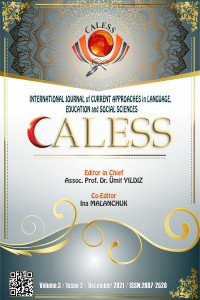Abstract
References
- Demir, N. (2018). Turkish reduplicative adjectives and adverbs. Proceedings of the Linguistic Society of America, 3(1), 19-1. https://doi.org/10.3765/plsa.v3i1.4300
- Finkbeiner, R. (2014). Identical constituent compounds in German. Word Structure, 7(2), 182-213. https://bit.ly/3zcZuDv
- Frankowsky, M. (n.d.). Extravagant expressions denoting quite normal entities: Contrastive focus reduplication in German.
- Freywald, U. (2015). Total reduplication as a productive process in German. The why and how of total reduplication: Current issues and new perspectives. Studies in language, 39(4), 905-945. https://doi.org/10.1075/sl.39.4.06fre
- Göksel, A., & Haznedar, B. (2007). Remarks on compounding in Turkish. MorboComp Project, University of Bologna. https://bit.ly/397PBMH
- Göksel A., & Kerslake, C. (2005). Turkish: A comprehensive grammar. Routledge.
- Gürkan, N. (2018). Typological classification of Turkish reduplication phenomena [Unpublished Thesis]. University of Göttingen.
- Hurch, B., Kajitani, M., Mattes, V., Stangel, U., & Vollmann, R. (2008). Other reduplication phenomena. Manuscript, University of Graz. [http://reduplication. uni-graz. at/, accessed April 25, 2013].
- Hurch, B., & Mattes, V. (Eds.). (2005). Studies on reduplication (No. 28). Walter de Gruyter.
- Kaufman, B. (2014). Learning an unproductive process: Turkish emphatic reduplication. Available from ProQuest Dissertations & Theses Global. http://0search.proquest.com.seyhan.library.boun.edu.tr/docview/1629480824?accountid=9645
- Kentner, G. (2017). On the emergence of reduplication in German morphophonology. Zeitschrift Für Sprachwissenschaft, 36(2).233–277.https://doi.org/10.1515/zfs-2017-0010
- Kim, H. S. (2009). The full-to-partial reduction in Korean and Turkish reduplication. Linguistic Research, 26(2), 121-148. https://bit.ly/3tJY2aH
- Krzeszowski, T. P. (1990). Contrasting languages: The scope of contrastive linguistics. Walter de Gruyter.
- Marantz, A. (1982). Re reduplication. Linguistic inquiry, 13(3), 435-482. https://www.jstor.org/stable/4178287
- Niebuhr, O., Jarzabkowska, P., Lorenz, U., Schulz, C., & Sodigov, F. (2012). Say it again, Sam! The prosodic profiles of emphatic reduplication in German. In Speech Prosody 2012. https://bit.ly/3CgwHzE
- Rubino, C. (2005). Reduplication: Form, function and distribution. Studies on reduplication, 11-29. https://bit.ly/3lkw7du
- Wiese, H., & Polat, N. T. (2016). Pejoration in contact. Linguistik Aktuell/Linguistics Today Pejoration, 241-268. https://doi.org/10.1075/la.228.11wie
- Wilbur, R. B. (1973). The phonology of reduplication. Indiana University Linguistics Club.
Abstract
The main goal of this study is to analyse the reduplicative structures in two languages: Turkish and German. Unlike German, Turkish is known as a language that actively uses productive reduplicative structures. There are different functions of these structures. They can be employed to produce new words in some languages or they can add different meanings to the existing words. They are mostly divided as partial and full reduplication. Also, some of the reduplication processes are productive, which means they can be used with new words unlike unproductive reduplication which can only be used with some specific words in that language. This study is a contrastive study and this requires three steps in the study: description, juxtaposition and comparison (Krzeszowski, 1990: 35). In the description step, the features of reduplication are defined and reduplicative processes in Turkish and German are described. In the second step, juxtaposition, the common ground to be compared in two languages are stated. At the end in the comparison step, the differences and similarities regarding reduplicative processes in two languages are determined related to type and degree. In terms of degree, both languages have full and partial reduplication. On the other hand, German has more types of reduplicative structures compared to Turkish. When two languages are compared regarding type, it is possible to state that German reduplicative structures are mostly unproductive, which means those structures are generally lexicalized or idiomatic expressions and do not allow for new words unlike Turkish.
Keywords
References
- Demir, N. (2018). Turkish reduplicative adjectives and adverbs. Proceedings of the Linguistic Society of America, 3(1), 19-1. https://doi.org/10.3765/plsa.v3i1.4300
- Finkbeiner, R. (2014). Identical constituent compounds in German. Word Structure, 7(2), 182-213. https://bit.ly/3zcZuDv
- Frankowsky, M. (n.d.). Extravagant expressions denoting quite normal entities: Contrastive focus reduplication in German.
- Freywald, U. (2015). Total reduplication as a productive process in German. The why and how of total reduplication: Current issues and new perspectives. Studies in language, 39(4), 905-945. https://doi.org/10.1075/sl.39.4.06fre
- Göksel, A., & Haznedar, B. (2007). Remarks on compounding in Turkish. MorboComp Project, University of Bologna. https://bit.ly/397PBMH
- Göksel A., & Kerslake, C. (2005). Turkish: A comprehensive grammar. Routledge.
- Gürkan, N. (2018). Typological classification of Turkish reduplication phenomena [Unpublished Thesis]. University of Göttingen.
- Hurch, B., Kajitani, M., Mattes, V., Stangel, U., & Vollmann, R. (2008). Other reduplication phenomena. Manuscript, University of Graz. [http://reduplication. uni-graz. at/, accessed April 25, 2013].
- Hurch, B., & Mattes, V. (Eds.). (2005). Studies on reduplication (No. 28). Walter de Gruyter.
- Kaufman, B. (2014). Learning an unproductive process: Turkish emphatic reduplication. Available from ProQuest Dissertations & Theses Global. http://0search.proquest.com.seyhan.library.boun.edu.tr/docview/1629480824?accountid=9645
- Kentner, G. (2017). On the emergence of reduplication in German morphophonology. Zeitschrift Für Sprachwissenschaft, 36(2).233–277.https://doi.org/10.1515/zfs-2017-0010
- Kim, H. S. (2009). The full-to-partial reduction in Korean and Turkish reduplication. Linguistic Research, 26(2), 121-148. https://bit.ly/3tJY2aH
- Krzeszowski, T. P. (1990). Contrasting languages: The scope of contrastive linguistics. Walter de Gruyter.
- Marantz, A. (1982). Re reduplication. Linguistic inquiry, 13(3), 435-482. https://www.jstor.org/stable/4178287
- Niebuhr, O., Jarzabkowska, P., Lorenz, U., Schulz, C., & Sodigov, F. (2012). Say it again, Sam! The prosodic profiles of emphatic reduplication in German. In Speech Prosody 2012. https://bit.ly/3CgwHzE
- Rubino, C. (2005). Reduplication: Form, function and distribution. Studies on reduplication, 11-29. https://bit.ly/3lkw7du
- Wiese, H., & Polat, N. T. (2016). Pejoration in contact. Linguistik Aktuell/Linguistics Today Pejoration, 241-268. https://doi.org/10.1075/la.228.11wie
- Wilbur, R. B. (1973). The phonology of reduplication. Indiana University Linguistics Club.
Details
| Primary Language | English |
|---|---|
| Journal Section | Research Articles |
| Authors | |
| Publication Date | December 31, 2021 |
| Published in Issue | Year 2021 Volume: 3 Issue: 2 |


